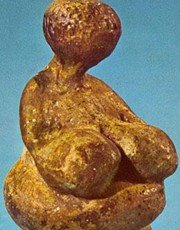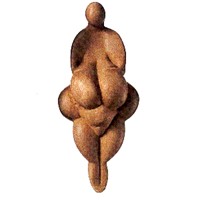Venus Figurines
Definition, Characteristics, Interpretation.
MAIN A-Z INDEX - A-Z of PREHISTORIC ART
|
Venus Figurines |
 Venus of Gagarino (c.20,000 BCE) Among the oldest art of Russia. |
Prehistoric Venus Figurines (30,000-20,000 BCE)Contents • What Are Venus
Figurines? |
|
|
Coinciding with the replacement of Homo sapiens neanderthalensis by anatomically modern humans like Cro-Magnon man, at the beginning of the Upper Paleolithic era of prehistory (from 40,000 BCE onwards), prehistoric art suddenly blossoms across Europe. This early Stone Age art fall into one of two broad categories: pictures and ideomorphs painted or drawn on the walls and ceilings of caves (parietal art), and prehistoric sculpture (mostly mobiliary art) typically small female "venus figurines", usually unearthed at Stone Age settlement sites. In archeology, the term "Venus Figurines" is an umbrella description relating to Stone Age statuettes of women, created during the Aurignacian or Gravettian cultures of the upper Palaeolithic (c.33,000-20,000 BCE), throughout Europe from France to Siberia. The general similarity of these sculptures - in size and shape [obese or pregnant] - is extraordinary. They were carved by Stone Age sculptors in all manner of different materials, ranging from soft stone (steatite, calcite or limestone), bone, ivory, wood, or ceramic clays. The latter type are among the oldest ceramic works yet discovered. |
 Venus of Lespugue (23,000 BCE). To see how Venus Figurines fit into the evolution of Stone Age art, see: Prehistoric Art Timeline. |
|
CHRONOLOGY OF |
Hundreds of such figurines are known, nearly all between 2 and 8 inches in height. Considered by late 19th century archeologists to represent the prehistoric idea of feminine beauty, they were dubbed "venuses" in reference to the Roman goddess of beauty. First Archeological
Discoveries of Venuses Most Venus figurines share similar characteristics of design and shape. Typically lozenge-shaped, with a wide fat belly tapering to the head and legs, they usually have no arms or feet, or any facial detail. Furthermore, their abdomen, hips, breasts, thighs, vulva are often deliberately exaggerated. Some are painted with red ochre. These general characteristics are more marked in earlier examples. Some paleoanthropologists theorize that these Venus figures were probably fertility symbols or some form of primitive religious icons. However, no clear consenus exists among scholars as to their cultural significance. For instance, Grahame Clark states that their meaning is "undeniably sensual", while Rene Nougier denies this emphatically. Walter Torbrügge claims that the Venus figurine is an "invocation of fertility", while experts at the school of Andre Leroi-Gourhan call it a fundamentally religious symbol: a contention flatly rejected by Charles Seltman. A fair conclusion is that the precise meaning of these extraordinary Venus sculptures is unlikely to be known, at least until the "religion", or at least the iconic role of females in the belief system of Stone age man is more fully understood. Earliest Known Venus Figurines Somewhat anomalous to the main period of Venus sculpture - the Aurignacian and Gravettian periods of the Upper Paleolithic era - two Venus-type carvings have been found within the Mediterranean area that predate the Upper Paleolithic by hundreds of thousands of years, making them by far the oldest Venus figurines known to archeology. These include: the Venus of Berekhat Ram, found on the Golan Heights between Israel and Syria, and the Venus of Tan-Tan, discovered in Morocco. Both originate from the Acheulean culture of the Lower Paleolithic epoch, and have been dated to between 200,000 and 300,000 BCE. Although some controversy still exists as to whether they are the product of human design, other even earlier discoveries of Lower Paleolithic art in India suggest that human fine art developed from a much earlier period than first supposed. |
|
List of Famous Venus Figurines Here is a selected list of the oldest and most famous examples of prehistoric venus sculpture. Lower Paleolithic (2,500,000-200,000 BCE) • Venus of Berekhat Ram (c.230,000
- 700,000 BCE) Upper Paleolithic (40,000-8,000 BCE) • Venus of Hohle Fels (38,000-33,000
BCE) Venus
of Berekhat Ram Venus
of Tan-Tan Venus
of Hohle Fels (Germany) Venus
of Galgenberg (Austria) Venus
of Dolni Vestonice (Czech Republic) Venus
of Monpazier (France) |
|
|
Venus of Willendorf (Austria) Venus
of Savignano (Italy) Venus
of Moravany (Slovakia) Venus
of Laussel (France) Venus
of Brassempouy (France) Venus
of Lespugue (France) Venus
of Kostenky (Russia) Venus
of Gagarino (Russia) Avdeevo
Venuses (Russia) Mal'ta
Venuses (Russia) Zaraysk
Venuses (Russia)
Venus
of Eliseevichi (14,000 BCE) Venus of
Engen (Petersfels) (Swiss) Venus
of Monruz-Neuchatel (Swiss)
|
|
• For murals, see also: Cave
Painting ENCYCLOPEDIA OF STONE AGE ART |